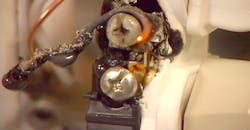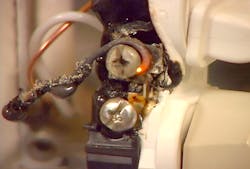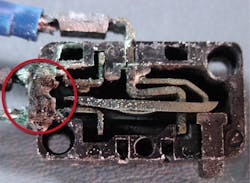The Basics of Electrical Overheating
As an electrician, you've probably seen or at least heard about electrical fires. Fortunately, they are not an everyday occurrence. However, the statistics surrounding them are sobering. According to data from the National Fire Protection Association (NFPA), Quincy, Mass., in 2006, an estimated 20,900 reported U.S. nonconfined home structure fires (involving electrical distribution or lighting equipment) resulted in 500 civilian deaths, 1,100 civilian injuries, and $862 million in direct property damage. What are the influencing factors behind these numbers?
Excessive current is rare because circuit breakers and fuses (if sized correctly) typically protect against this occurrence.
Poor connections can be very efficient at overheating, because they can generate a high wattage over a small area for a long period of time. This is evidenced in the research from William J. Meese and Robert W. Beausoliel in the “Exploratory Study of Glowing Electrical Connections,” published by the National Bureau of Standards, and NFPA 921, the “Guide for Fire and Explosion Investigations” from NFPA. If the watt density is high enough, the connection will glow. An oxide actually forms at the (loose) contact area, and the resistance of the oxide causes the I2R power dissipation.
Photo 1 shows a glowing connection at a common receptacle with a current of 12A with a 12 AWG conductor. If we're lucky, proper enclosing of these connections will keep an occurrence like this from igniting nearby combustibles, such as wood and cellulose insulation. Even though a poor connection is hazardous, there is currently no way to detect a poor connection as soon as it begins. A GFCI or AFCI may sense a poor connection after some electrical insulation becomes conductive and leakage current occurs (5 mA or 30 mA, respectively).
The red circles in Photo 2 show evidence of oxide buildup and small areas of melting due to the series arcing on the wire and the underside of the screw.
One of the more misunderstood modes of overheating is insulation breakdown. On one hand, we know how frayed cords can cause overheating when the insulation is defeated, and strands of the hot wire touch strands of the neutral or ground wire (see Stand Your Ground). This causes a parallel short circuit and arc — and sparks may be ejected/can ignite nearby fine combustibles, such as paper. However, there are other ways for an overheating occurrence to ignite into flaming combustion, one of which is called arc tracking, according to Sec. 8.9.4.5. of NFPA 921, the “Guide for Fire and Explosion Investigations.”
Over time, this current can degrade the plastic, turning a hydrocarbon into elemental carbon, which is semi-conductive. This carbon itself can then conduct increasing amounts of leakage current, which can then glow and ignite combustible gases coming off the plastic material. Dry arc tracking can occur without a liquid and may begin by the thermal degradation in the vicinity of a poor connection, such as that seen in Photo 1. Photo 3 illustrates lab-induced dry arc tracking and wet arc tracking situations on a plug face and microswitch, respectively.
Photo 4 depicts a close-up of the inside of the microswitch in which the wet arc tracking occurred between the contacts in the area shown by the red oval. In this case, the degraded carbon in the plastic conducted current across its surface to cause the overheating.
What are some of the things that can be done to improve electrical safety other than following the NEC and additional common requirements?
• Think critically about hazardous or marginal applications and locations (saw mills, dusty areas, pool pump rooms), and consider upgrading from an indoor to a hazardous-rated enclosure.
• Avoid the poor wiring practices, as noted in Potential Problem Areas.
Korinek, P.E., is a forensic engineer and president of Synergy Technologies LLC in Cedarburg, Wis. He can be reached at [email protected].
Sidebar: Potential Problem Areas
Some commonly known defective wiring practices that can lead to electrical fires include:
• Loose connections.
• Aluminum and copper conductors spliced together with an incorrect connector. Aluminum oxide causes overheating.
• Some insulation piercing connectors when applied incorrectly can make poor connections due to insufficient contact area or pressure.
Some fairly unknown or rare issues include:
• NM cable, if placed against sharp edges of steel truss nailing plates, can have its insulation cut. This can cause overheating as current flows from the “hot” conductor to the steel through the sharp edge, and finally to the neutral or ground conductor (most likely due to a poor connection). If the cable is not secured sufficiently — and stress is placed on the cable — this can also cause the insulation to be cut. It is believed that wires lightly contacting the sharp edge can allow heating without tripping a circuit breaker.
• Appliances with water involved (such as dishwashers and aquariums) can be fire and shock hazards. Precautions can be taken, however, such as installing GFCIs or AFCIs with sufficient grounding systems to lessen shock and fire hazards. The photo below shows the aftermath of an aquarium light that started a fire due to a poor connection at one of the fluorescent light pins.
• Low-voltage applications (such as high-current landscape lighting) with field connections that are exposed to combustibles, such as wood siding, can be dangerous. A glowing connection drawing 15A or more can generate significant heat and may ignite these combustibles. I have heard professionals say, “It's only 12V; it should be safe.” Of course, this is safe for a shock concern, but it's definitely dangerous from a fire standpoint, as overheating due to a poor connection is a function of current and is generally independent of voltage.
Sidebar: Stand Your Ground
Historically, grounding has been present primarily for shock protection when actually it has increased the risk of fire. A poor connection in a ground conductor network (possibly with conduit or armored cable) carrying current can certainly be a fire hazard, especially when the grounding conductor has been neglected under the rationalization that “it is only a ground” and thereby not important. A GFCI and AFCI can protect against both shock and fire hazards when a ground is present.




